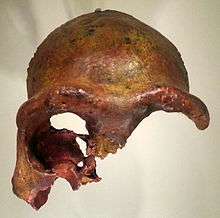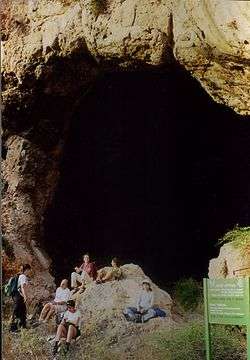Mugharet el-Zuttiyeh
| Mugharet el-Zuttiyeh | |
|
Entrance to Zuttiyeh Cave, Galilee | |
 Shown within Israel | |
| Alternate name | Cave of the Robbers |
|---|---|
| Region | Upper Galilee, Israel |
| Coordinates | 32°51′21″N 35°31′38″E / 32.855797°N 35.527210°ECoordinates: 32°51′21″N 35°31′38″E / 32.855797°N 35.527210°E |
| Type | limestone cave |
| History | |
| Cultures | Acheulo-Yabrudian complex |
| Associated with | Homo heidelbergensis |
| Site notes | |
| Archaeologists | Francis Turville-Petre |
Mugharet el-Zuttiyeh ("Cave of the Robbers")[1] is a prehistoric archaeological site in Upper Galilee, Israel.[2] It is situated 0.8 km from the Nahal Amud outlet, approximately 30 m above the wadi bed (148 m below sea level). It was found to house a fossil today known as the "Galilee skull" and "Galilee Man".[3] Discovered in 1925, the skull was the first ancient fossilised hominin (primitive man) found in Western Asia.[4] Together with the remains found at Es Skhul and the Wadi el-Mughara Caves, this find was classified in 1939 by Arthur Keith and Theodore D. McCown as Palaeoanthropus palestinensis (Palestinian Neanderthal).[5][6][7] Today its taxonomy is that of Homo heidelbergensis.[8]
Geography
Zuttiyeh cave is at the opening of a limestone ravine where Nahal Amud turns eastward, 250 meters above a smaller cave known as Mugharet el-Emireh (Cave of the Princess).[9]
History

The cave was excavated in 1925-1926 by Francis Turville-Petre.[8] It was the first paleontological excavation in the region.[11] Turville-Petre discovered a skull, referred to as the Galilee skull, that was initially described as the second Neanderthal-like specimen. It was originally attributed to a Mousterian level and is now thought to be from an earlier Acheulo-Yabrudian complex. Later studies showed that the face was relatively flat, with no evidence of Neanderthal-like facial prognathism.[8]
The frontal bone and part of the upper face were found in the Mugharan level, which leads to an estimate of the age of the fossil to range from 300-200 Ka BP. Similarities with Zhoukoudian remains suggest a possible ancestral relationship.[12]
The Galilee skull, along with many of Turville-Petre's findings, is housed in the Rockefeller Museum in East Jerusalem.[3][4] A cast of the skull is on display at the Israel Museum.[10]
See also
References
- ↑ "A comprehensive morphometric analysis of the frontal and zygomatic bone of the Zuttiyeh fossil from Israel" (PDF). Retrieved 2013-04-25.
- ↑ Human Evolution (2011-12-17). "The Zuttiyeh specimen from Israel, Galilee Skull". Pfpuech.newsvine.com. Retrieved 2013-04-25.
- 1 2 Rast, Walter E. (1992). Through the Ages in Palestinian Archaeology: An Introductory Handbook. Continuum International Publishing Group. p. 50. ISBN 9781563380556. "Galilee man" (lowercase "m") in this source is a typo – ref. Solo Man, Peking Man and so forth.
- 1 2 Cohen, Getzel M.; Joukowsky, Martha (2004). Breaking Ground: Pioneering Women Archaeologists. University of Michigan Press. Retrieved 2013-04-25.
- ↑ Pettitt, Paul (2013). The Palaeolithic Origins of Human Burial. Routledge. p. 59.
- ↑ Rabett, Ryan J. (2012). Human Adaptation in the Asian Palaeolithic: Hominin Dispersal and Behaviour during the Late Quaternary. Cambridge University Press. p. 90.
- ↑ The stone age of Mount Carmel : report of the Joint Expedition of the British School of Archaeology in Jerusalem and the American School of Prehistoric Research, 1929–1934, p18
- 1 2 3 Cartmill, Matt; Smith, Fred H. (2009). The Human Lineage. John Wiley & Sons. p. 320. ISBN 0471214914. Retrieved 2013-03-01.
- ↑ Garrod, D. E. A. (1955). "The Mugharet el-Emireh in Lower Galilee: Type-Station of the Emiran Industry". Journal of the Royal Anthropological Institute of Great Britain and Ireland. 85 (1/2): 141–162. JSTOR 2844188.
- 1 2 "The Israel Museum Permanent Exhibitions: Archaeology Wing – The Dawn of Civilization". New York: The Ridgefield Foundation. 1995. Skull (cast) Zuttiyeh Cave Lower Palaeolithic. Retrieved 2013-03-13.
- ↑ "Excavations in Wadi Amud". Persee.fr. Retrieved 2013-04-25.
- ↑ "Zuttiyeh face: A view from the East". 91. National Center for Biotechnology Information. 2013-03-25: 325–47. doi:10.1002/ajpa.1330910307. PMID 8333489.
Further reading
| Wikimedia Commons has media related to Zuttiyeh cave. |
- Lahr, Marta Mirazón (1996). The evolution of modern human diversity: a study of cranial variation. Cambridge University Press. ISBN 0-521-47393-4.
- Delson, Eric; Tattersall, Ian; Van Couvering, John A. (2000). Encyclopedia of human evolution and prehistory. Taylor & Francis. ISBN 0-203-00942-8.
External links
- What does it mean to be human?
- On the Animal Remains Obtained from the Mugharet-el-Zuttiyeh in 1925 & 1926 at Google Books
